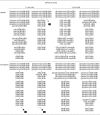Investigating children as cultural magnets: do young children transmit redundant information along diffusion chains? - PubMed (original) (raw)
Comparative Study
Investigating children as cultural magnets: do young children transmit redundant information along diffusion chains?
Emma Flynn. Philos Trans R Soc Lond B Biol Sci. 2008.
Abstract
The primary goal of this study was to investigate cultural transmission in young children, with specific reference to the phenomenon of overimitation. Diffusion chains were used to compare the imitation of 2- and 3-year-olds on a task in which the initial child in each chain performed a series of relevant and irrelevant actions on a puzzle box in order to retrieve a reward. Children in the chains witnessed the actions performed on one of two boxes, one which was transparent and so the lack of causality of the irrelevant actions was obvious, while the other was opaque and so the lack of causal relevance was not obvious. Unlike previous dyadic research in which children overimitate a model, the irrelevant actions were parsed out early in the diffusion chains. Even though children parsed out irrelevant actions, they showed fidelity to the method used to perform a relevant action both within dyads and across groups. This was true of 3-year-olds, and also 2-year-olds, therefore extending findings from previous research.
Figures
Figure 1
The two glass ceiling boxes: (a) the transparent box with the tool being tapped in the upper compartment and (b) the opaque box with the door in the lift position and the tool inserted into the opaque tube that contains the reward.
Figure 2
Transmission along diffusion chains. Each row of seven bracketed symbols represents a child's attempt on a GCB. The upper two rows of each set of four are attempts and the lower two rows are demonstrations: (db) represents dragging the bolts, (pb) represents pushing the bolts, (hp) represents poking and pulling the bolts with one's hand, (tb) refers to children who touched the bolts but did not move them, (t) represents tapping into the upper compartment (the initial demonstrator did this three times, only the first three taps are illustrated although some children made more), (LD) represents lifting the door open, (SDL) or (SDR) represent sliding the door open either towards the left or right, (tu) refers to children who used the tool rather than their hand to move the door, sometimes children moved the door more than once (e.g. ×20 means moving the door 20 times) and (RR) represents retrieving the reward. A symbol that does not appear means that the behaviour it represents was not produced during that attempt. A black rectangle to the side of a chain represents a child who was allocated to a chain but did not participate in the chain. Actions represented with uppercase letters are causally necessary actions, while actions represented with lowercase letters were not causally necessary.
Similar articles
- The role of transmission biases in the cultural diffusion of irrelevant actions.
McGuigan N. McGuigan N. J Comp Psychol. 2012 May;126(2):150-60. doi: 10.1037/a0025525. Epub 2011 Sep 26. J Comp Psychol. 2012. PMID: 21942570 - Cultural variation in the use of overimitation by the Aka and Ngandu of the Congo Basin.
Berl RE, Hewlett BS. Berl RE, et al. PLoS One. 2015 Mar 27;10(3):e0120180. doi: 10.1371/journal.pone.0120180. eCollection 2015. PLoS One. 2015. PMID: 25816230 Free PMC article. - Emulation and "overemulation" in the social learning of causally opaque versus causally transparent tool use by 23- and 30-month-olds.
McGuigan N, Whiten A. McGuigan N, et al. J Exp Child Psychol. 2009 Dec;104(4):367-81. doi: 10.1016/j.jecp.2009.07.001. Epub 2009 Aug 15. J Exp Child Psychol. 2009. PMID: 19683722 - The Rationality of (Over)imitation.
Keupp S, Behne T, Rakoczy H. Keupp S, et al. Perspect Psychol Sci. 2018 Nov;13(6):678-687. doi: 10.1177/1745691618794921. Epub 2018 Oct 9. Perspect Psychol Sci. 2018. PMID: 30301424 Review. - Imitation of a bimanual task in preschool- and school-age children: a hierarchical construction.
Labiadh L, Ramanantsoa MM, Golomer E. Labiadh L, et al. J Electromyogr Kinesiol. 2012 Aug;22(4):513-9. doi: 10.1016/j.jelekin.2012.01.016. Epub 2012 Mar 4. J Electromyogr Kinesiol. 2012. PMID: 22391341 Review.
Cited by
- Cumulative culture in the laboratory: methodological and theoretical challenges.
Miton H, Charbonneau M. Miton H, et al. Proc Biol Sci. 2018 May 30;285(1879):20180677. doi: 10.1098/rspb.2018.0677. Proc Biol Sci. 2018. PMID: 29848653 Free PMC article. Review. - Innovation through neurodiversity: Diversity is beneficial.
Axbey H, Beckmann N, Fletcher-Watson S, Tullo A, Crompton CJ. Axbey H, et al. Autism. 2023 Oct;27(7):2193-2198. doi: 10.1177/13623613231158685. Epub 2023 Mar 7. Autism. 2023. PMID: 36880441 Free PMC article. - Review. Studying cumulative cultural evolution in the laboratory.
Caldwell CA, Millen AE. Caldwell CA, et al. Philos Trans R Soc Lond B Biol Sci. 2008 Nov 12;363(1509):3529-39. doi: 10.1098/rstb.2008.0133. Philos Trans R Soc Lond B Biol Sci. 2008. PMID: 18799419 Free PMC article. Review. - Introduction. Cultural transmission and the evolution of human behaviour.
Smith K, Kalish ML, Griffiths TL, Lewandowsky S. Smith K, et al. Philos Trans R Soc Lond B Biol Sci. 2008 Nov 12;363(1509):3469-76. doi: 10.1098/rstb.2008.0147. Philos Trans R Soc Lond B Biol Sci. 2008. PMID: 18799420 Free PMC article. - Identifying innovation in laboratory studies of cultural evolution: rates of retention and measures of adaptation.
Caldwell CA, Cornish H, Kandler A. Caldwell CA, et al. Philos Trans R Soc Lond B Biol Sci. 2016 Mar 19;371(1690):20150193. doi: 10.1098/rstb.2015.0193. Philos Trans R Soc Lond B Biol Sci. 2016. PMID: 26926283 Free PMC article. Review.
References
- Baldwin J.M. MacMillan; New York, NY: 1902. Development and evolution.
- Bangerter A. Transformation between scientific and social representations of conception: the method of serial production. Br. J. Social Psychol. 2000;39:521–535. doi:10.1348/014466600164615 - DOI - PubMed
- Bartlett F.C. Macmillan; Oxford, UK: 1932. Remembering.
- Bauer P. Holding it all together: how enabling relations facilitate young children's event recall. Cognit. Dev. 1992;7:1–28. doi:10.1016/0885-2014(92)90002-9 - DOI
- Bekkering H, Brass M, Woschina S, Jacobs A.M. Goal-directed imitation in patients with ideomotor apraxia. Cognit. Neuropsychol. 2005;22:419–432. doi:10.1080/02643290442000275 - DOI - PubMed
Publication types
MeSH terms
LinkOut - more resources
Full Text Sources

